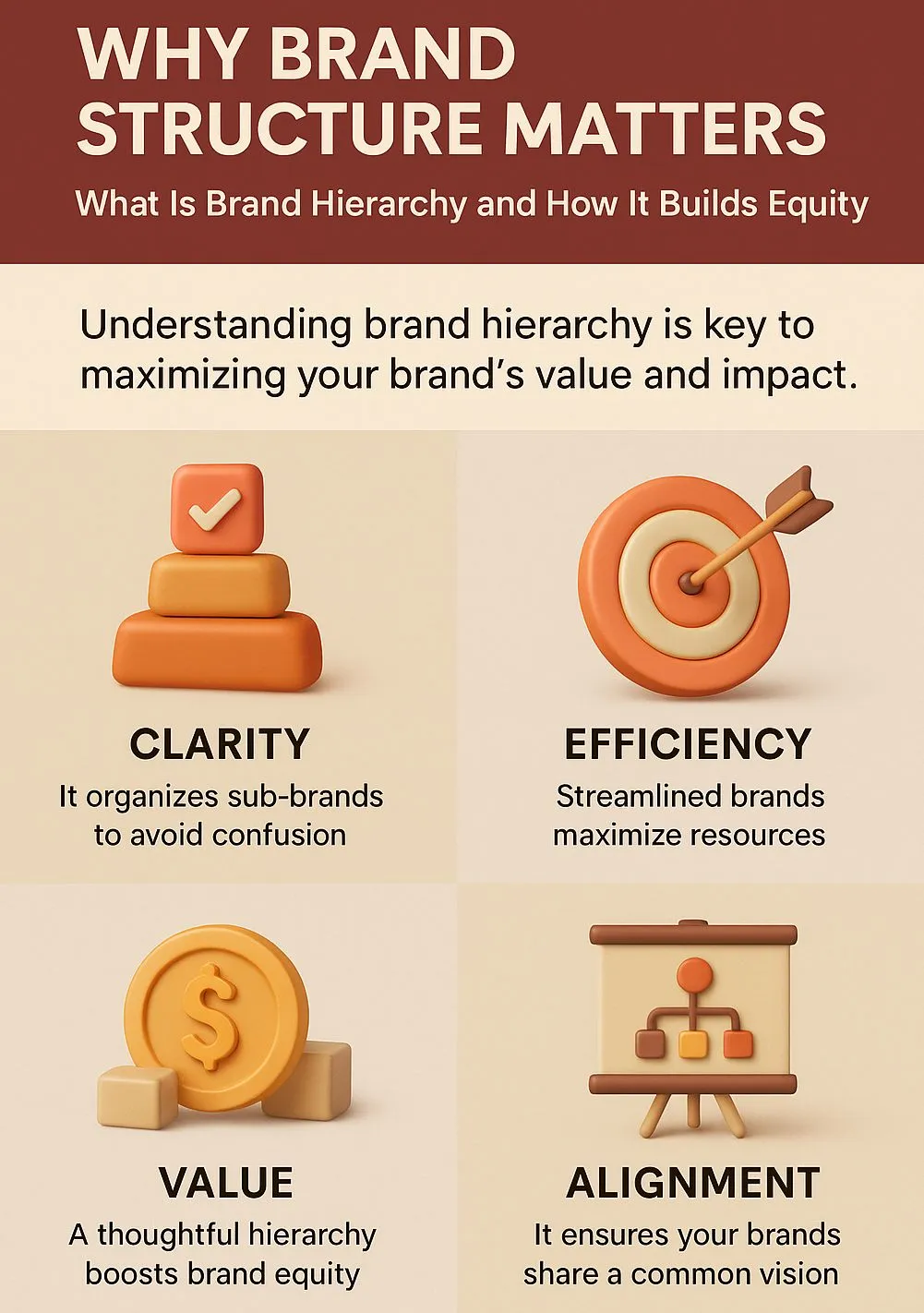Brand equity doesn’t just come from catchy logos or well-placed ads—it comes from clarity. When a company’s products, services, or sub-brands don’t relate to each other in a clear, intentional way, even the strongest branding efforts can fall flat. That’s where brand hierarchy comes into play.
We’ve helped numerous businesses realign their branding systems, and in nearly every case, one truth holds: structure builds value. A smart brand hierarchy doesn’t just organize your assets—it reinforces customer trust and strengthens your market position. Understanding what is brand hierarchy is essential to leveraging this tool effectively and ensuring that every brand decision contributes to long-term growth.
Top Keytakeaways
- It aligns teams, reduces costs, and drives consistency across platforms
- It’s easier to scale when your structure is already in place
- Brand equity grows when customers understand and recognize your brand ecosystem
Understanding Brand Hierarchy and Its Equity-Building Power
At its core, brand hierarchy is the strategic architecture behind how your company presents its brands, sub-brands, and offerings. It defines the relationship between your overarching company identity and everything it supports—from standalone products to sub-labels and endorsed names.
Without this structure, messaging becomes inconsistent, and customer perception suffers. With it, your brand can communicate with precision, scale efficiently, and reinforce recognition across every customer touchpoint.
From our direct work with multi-brand businesses, we’ve seen how clear brand structures solve confusion, reduce overlap, and create alignment from marketing to operations—especially when guided by experienced Black-owned marketing agencies that bring cultural insight and strategic clarity.
"The most effective brands aren’t just creative—they’re organized. When each brand has a purpose and place, equity grows naturally."

Brand Hierarchy in Action: A Realignment That Drove Results
A national home services brand we worked with had grown through acquisitions. While the services were strong, brand presence was fragmented across regions.
What Went Wrong:
- No unified identity across acquired brands
- Mixed logos and taglines led to low brand recall
- Teams operated in silos, doubling marketing spend
What We Did:
- Elevated the parent brand as the anchor across all locations
- Introduced endorsed branding, using “Powered by [Master Brand]” across regional branches
- Standardized product naming, improving clarity for internal teams and customers
What Happened:
- 43% increase in brand recognition within six months
- 21% drop in marketing costs
- Higher customer trust and loyalty in post-service feedback
The result was more than cosmetic. It was a measurable increase in brand equity—a transformation often achieved with the strategic guidance of experienced branding agencies.
Data-Backed Proof That Structure Matters
Brand hierarchy is more than a theory—it’s backed by industry research and customer behavior insights:
- 81% of U.S. consumers say they must trust a brand before purchasingSource: Edelman Trust Barometer
- Consistent branding can increase revenue by up to 20%Source: Lucidpress Branding Report
- Marketing strategy roles are expected to grow 8% through 2033Source: U.S. Bureau of Labor Statistics
This supports what we’ve observed: brand structure builds trust, and trust builds equity.
How to Start Structuring Your Brand the Right Way
To begin strengthening your brand equity through hierarchy:
- Map your full brand portfolio
- Classify each brand as master, sub-brand, endorsed, or product-level
- Ensure naming, visuals, and tone are aligned across levels
- Create a brand architecture reference guide
- Review it regularly, especially during launches or rebrands
Tip: Involve multiple departments early—brand structure should reflect business reality, not just marketing goals, especially when collaborating with a multicultural digital marketing agency that understands how diverse perspectives shape brand perception.
Frequently Asked Questions
What is brand hierarchy and how does it impact brand equity?
Brand hierarchy is the structured system a company uses to organize its master brand, sub-brands, endorsed brands, and products. A clear hierarchy enhances brand recognition, customer trust, and long-term brand equity by creating consistent, easy-to-understand relationships between brand elements.
Why does brand structure matter for growing companies?
As companies expand—through new offerings, acquisitions, or rebranding—structure becomes essential. Without a defined hierarchy, messaging becomes fragmented, brand equity becomes diluted, and marketing becomes less efficient. Structure keeps everything aligned.
What are the main components of a strong brand hierarchy?
A well-designed hierarchy typically includes:
- A master (corporate) brand
- Endorsed brands that leverage the parent’s trust
- Sub-brands with semi-distinct identities
- Product-level brands that may stand alone or fit under sub-brands
Each level should support the company’s overall brand equity strategy.
How does a brand hierarchy affect the customer experience?
A structured brand helps customers navigate offerings more easily. When brand relationships are clear, customers feel more confident in what they're buying, which builds loyalty and deepens brand equity over time.
Can brand hierarchy help small businesses build stronger brand equity?
Absolutely. Even simple structures can clarify what a business stands for, how its services relate to each other, and how customers should engage with the brand. This clarity is foundational to building trust, recognition, and long-term value—even on a small scale.
Establishing a clear brand hierarchy is essential to building long-term brand equity—it ensures every product, service, and communication aligns with a unified identity. Just as HVAC professionals rely on precise tools and trusted products to maintain efficiency and clarity in complex systems, small businesses can benefit from structured brand architecture that streamlines decision-making and strengthens customer trust. For example, using high-performance solutions like the BDP 16x25x3 Air Filters (MERV 13) ensures air quality and system efficiency, reflecting how a well-organized brand hierarchy boosts performance across touchpoints. Similarly, professional services like those offered at HVAC Maintenance Boca Raton FL demonstrate the importance of consistent, specialized execution. Whether it’s stocking reliable 20x25x1 pleated furnace filters, choosing 14x20x1 MERV 8 HVAC filters, or sourcing essentials like those on eBay, each choice mirrors how clarity in branding drives quality, trust, and equity in the market.



